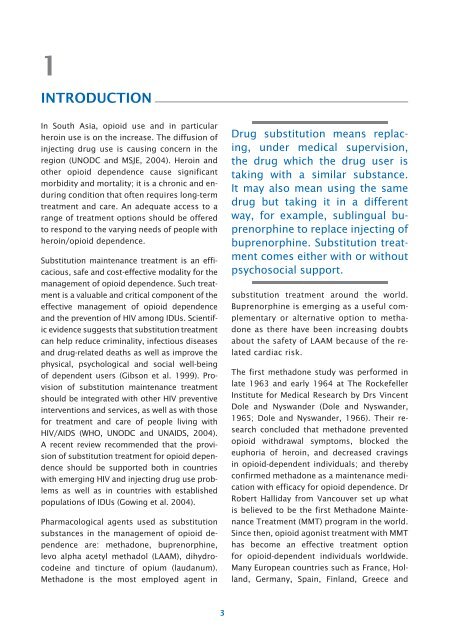methadone maintenance treatment - United Nations Office on Drugs ...
methadone maintenance treatment - United Nations Office on Drugs ...
methadone maintenance treatment - United Nations Office on Drugs ...
You also want an ePaper? Increase the reach of your titles
YUMPU automatically turns print PDFs into web optimized ePapers that Google loves.
1<br />
INTRODUCTION<br />
In South Asia, opioid use and in particular<br />
heroin use is <strong>on</strong> the increase. The diffusi<strong>on</strong> of<br />
injecting drug use is causing c<strong>on</strong>cern in the<br />
regi<strong>on</strong> (UNODC and MSJE, 2004). Heroin and<br />
other opioid dependence cause significant<br />
morbidity and mortality; it is a chr<strong>on</strong>ic and enduring<br />
c<strong>on</strong>diti<strong>on</strong> that often requires l<strong>on</strong>g-term<br />
<str<strong>on</strong>g>treatment</str<strong>on</strong>g> and care. An adequate access to a<br />
range of <str<strong>on</strong>g>treatment</str<strong>on</strong>g> opti<strong>on</strong>s should be offered<br />
to resp<strong>on</strong>d to the varying needs of people with<br />
heroin/opioid dependence.<br />
Substituti<strong>on</strong> <str<strong>on</strong>g>maintenance</str<strong>on</strong>g> <str<strong>on</strong>g>treatment</str<strong>on</strong>g> is an efficacious,<br />
safe and cost-effective modality for the<br />
management of opioid dependence. Such <str<strong>on</strong>g>treatment</str<strong>on</strong>g><br />
is a valuable and critical comp<strong>on</strong>ent of the<br />
effective management of opioid dependence<br />
and the preventi<strong>on</strong> of HIV am<strong>on</strong>g IDUs. Scientific<br />
evidence suggests that substituti<strong>on</strong> <str<strong>on</strong>g>treatment</str<strong>on</strong>g><br />
can help reduce criminality, infectious diseases<br />
and drug-related deaths as well as improve the<br />
physical, psychological and social well-being<br />
of dependent users (Gibs<strong>on</strong> et al. 1999). Provisi<strong>on</strong><br />
of substituti<strong>on</strong> <str<strong>on</strong>g>maintenance</str<strong>on</strong>g> <str<strong>on</strong>g>treatment</str<strong>on</strong>g><br />
should be integrated with other HIV preventive<br />
interventi<strong>on</strong>s and services, as well as with those<br />
for <str<strong>on</strong>g>treatment</str<strong>on</strong>g> and care of people living with<br />
HIV/AIDS (WHO, UNODC and UNAIDS, 2004).<br />
A recent review recommended that the provisi<strong>on</strong><br />
of substituti<strong>on</strong> <str<strong>on</strong>g>treatment</str<strong>on</strong>g> for opioid dependence<br />
should be supported both in countries<br />
with emerging HIV and injecting drug use problems<br />
as well as in countries with established<br />
populati<strong>on</strong>s of IDUs (Gowing et al. 2004).<br />
Pharmacological agents used as substituti<strong>on</strong><br />
substances in the management of opioid dependence<br />
are: <str<strong>on</strong>g>methad<strong>on</strong>e</str<strong>on</strong>g>, buprenorphine,<br />
levo alpha acetyl methadol (LAAM), dihydrocodeine<br />
and tincture of opium (laudanum).<br />
Methad<strong>on</strong>e is the most employed agent in<br />
Drug substituti<strong>on</strong> means replacing,<br />
under medical supervisi<strong>on</strong>,<br />
the drug which the drug user is<br />
taking with a similar substance.<br />
It may also mean using the same<br />
drug but taking it in a different<br />
way, for example, sublingual buprenorphine<br />
to replace injecting of<br />
buprenorphine. Substituti<strong>on</strong> <str<strong>on</strong>g>treatment</str<strong>on</strong>g><br />
comes either with or without<br />
psychosocial support.<br />
substituti<strong>on</strong> <str<strong>on</strong>g>treatment</str<strong>on</strong>g> around the world.<br />
Buprenorphine is emerging as a useful complementary<br />
or alternative opti<strong>on</strong> to <str<strong>on</strong>g>methad<strong>on</strong>e</str<strong>on</strong>g><br />
as there have been increasing doubts<br />
about the safety of LAAM because of the related<br />
cardiac risk.<br />
The first <str<strong>on</strong>g>methad<strong>on</strong>e</str<strong>on</strong>g> study was performed in<br />
late 1963 and early 1964 at The Rockefeller<br />
Institute for Medical Research by Drs Vincent<br />
Dole and Nyswander (Dole and Nyswander,<br />
1965; Dole and Nyswander, 1966). Their research<br />
c<strong>on</strong>cluded that <str<strong>on</strong>g>methad<strong>on</strong>e</str<strong>on</strong>g> prevented<br />
opioid withdrawal symptoms, blocked the<br />
euphoria of heroin, and decreased cravings<br />
in opioid-dependent individuals; and thereby<br />
c<strong>on</strong>firmed <str<strong>on</strong>g>methad<strong>on</strong>e</str<strong>on</strong>g> as a <str<strong>on</strong>g>maintenance</str<strong>on</strong>g> medicati<strong>on</strong><br />
with efficacy for opioid dependence. Dr<br />
Robert Halliday from Vancouver set up what<br />
is believed to be the first Methad<strong>on</strong>e Maintenance<br />
Treatment (MMT) program in the world.<br />
Since then, opioid ag<strong>on</strong>ist <str<strong>on</strong>g>treatment</str<strong>on</strong>g> with MMT<br />
has become an effective <str<strong>on</strong>g>treatment</str<strong>on</strong>g> opti<strong>on</strong><br />
for opioid-dependent individuals worldwide.<br />
Many European countries such as France, Holland,<br />
Germany, Spain, Finland, Greece and<br />
3
















